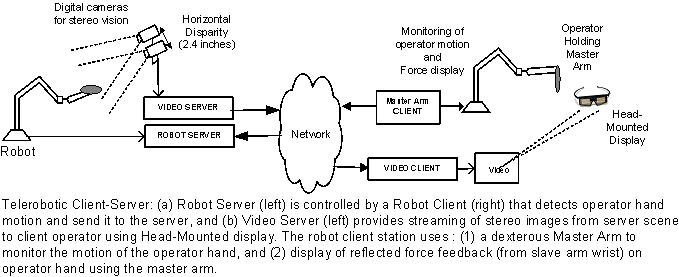 Please see the following papers for more details:
Please see the following papers for more details:
-
Mayez Al-Mouhamed, Onur Toker, and
Abdul-Khalik Al-Harthy, “A
3D Vision-Based Man-Machine Interface For Hand-Controlled Telerobot”,
IEEE Transactions on Industrial Electronics,
Vol 52, No
1, 2005, pp. 306-319.
-
Mayez A. Al-Mouhamed, Mohammad Nazeeruddin, and Syed M.S.
Islam,
Experimentation of a Multi-Threaded Distributed Telerobotic Framework,
Under review with
the IEEE
Trans. on Instrumentation and Measurements,
January, 2008.
-
Mayez A. Al-Mouhamed, Onur Toker, and Asif Iqbal,
A Multi-Threaded
Distributed Telerobotic Framework, IEEE T.on Mechatronics, Vol 11,
No 5, Oct., 2006. pp. 558-566.
-
Mayez A. Al-Mouhamed, Mohammad Nazeeruddin, and Nesar
Merah,
Design and Analysis of Force Feedback in Telerobotics, IEEE T. on
Instrumentation and Measurements,
Vol 58, No
6, 2009, pp.1949-1957.
-
Mayez A. Al-Mouhamed, Onur Toker, and Asif Iqbal,
Experimental
Evaluation of Feedback Modalities for Five Teleoperation Tasks,
Accepted for publication,
The
IEEE Trans. on Instrumentation and Measurements,
Accepted for future publication, Volume PP,
Forthcoming, 2009 Page(s):1 – 1, Digital Object Identifier
10.1109/TIM.2009.2023828.
Mayez A. Al-Mouhamed, Mohammad Nazeeruddin, and Syed M.S.
Islam, Performance Evaluation of
a
Multi-Threaded Distributed Telerobotic Framework, Under review with
the IEEE Trans. on Instrumentation and Measurements,
January, 2008.
Mayez Al-Mouhamed, Onur Toker, Asif Iqbal, and M.
Nazeeruddin, A Distributed
Framework for Relaying Stereo Vision for Telerobotics, IEEE Inter.
Conference on Pervasive Services, Beirut, Lebanon, July 19-23, 2004, pp.
221-225.
M. Al-Mouhamed, M. Nazeeruddin, and A. Iqbal,
A Modular Distributed
Telerobotic Client-Server System, Inter. Conference on Information
and Computer Science (ICICS’04), KFUPM, Dhahran, KSA, Nov, 28-30, 2004,
Mayez A. Al-Mouhamed, Onur Toker, Asif Iqbal, and Syed
M.S. Islam, Evaluation of
Real-Time Delays for Networked Telerobotics, 3rd Inter.
IEEE Conference on Industrial Informatics (INDIN’05), 10-12 August 2005,
Perth, Western Australia, pp. 351-356.
Mayez A. Al-Mouhamed, Mohammad
Nazeeruddin, and Syed M.S. Islam,
Evaluation of
Assembly Tasks in Augmented Telerobotics, 2nd International AUS
Symposium on Mechatronics
(AUS-ISM05), April 19-21, 2005, Sharjah,
UAE.
Al-Mouhamed, M., Buhari, S.M.,
Nazeeruddin, M., Islam, S.M.S., “Qualitative
Evaluation of Computer-Aided Teleopearation”, In Proc. of the 4th
ACS/IEEE International Conference on Computer Systems and Applications
(AICCSA-06), March 8-11, 2006, Dubai,Sharjah, UAE.
M. A. Al-Mouhamed, M. Nazeeruddin,
and N. Merah, Design
and Analysis of Force Feedback in Telerobotics, 3rd International
AUS Symposium on Mechatronics, April 18-20, 2006, Sharjah, UAE.
Syed M.S. Islam, M. Al-Mouhamed, S.M.
Buhari, and Talal Al-Kharoubi, “A
Hierarchical Design Scheme for Application of Augmented Reality in a
Telerobotic Stereo-Vision System”, the Saudi 18th
National Computer Conference (NCC18),
March 26-29, 2006. Riyadh, KSA.
M. A. Al-Mouhamed, M. Nazeeruddin,
and N. Merah,
Force-Based Compliant Behaviors to Augment Telerobotics, 4th
International AUS Symposium on Mechatronics, March 26-29, 2007, Sharjah,
UAE.
M. Al-Mouhamed and U. F. Siddiqi,
Performance
Evaluation of Auctions WLAN for RoboCup Multi-Robot Cooperation, The
7th ACS/IEEE International Conference on Computer Systems and
Applications (AICCSA-2009), 10-13 May 2009, Page(s):610 – 615.
|

